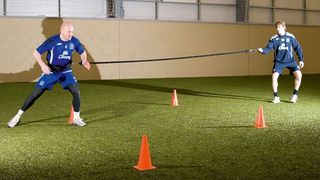Football Sprint Workout
Get faster over the first five yards with this session from Everton’s head of sports science

This article was published by Men’s Fitness UK in April 2008. It was reformatted in 2022 to make it easier to read.
Every player wants to improve at football and one of the most effective things spend your time developing is speed. Everton’s head of sports science Dave Billows told us how important sprinting is in football. “I’ve worked with lots of athletes, including sprinters, and footballers can accelerate over the first 20 metres faster than anyone,” says Bellow. “The first five metres are so important in football because if your pick-up isn’t quick enough, you aren’t going to keep hold of the ball.”
Here, Bellow talks us through a routine to improve your sprint speed. He’s also shared a pre-match dynamic warm-up sequence so your joints can handle the power you’ll develop by doing the following.
1 Box jump
Sets 5 Reps 6, 5, 4, 5, 6
- Stand facing a waist-high box, with your feet shoulder-width apart.
- Drop into a half-squat and swing your arms backwards.
- Explosively swing your arms forwards and upwards and straighten your legs, taking off with both feet.
- Jump up and forwards to land on the box, bending your knees to absorb the impact.
Bellow says: “By extending and then contracting your lower-body muscles, you make this a plyometric exercise to turn raw strength into power, raising your jump height for headers as well as improving your explosive speed.”
2 Sled sprint
Sets 6 Distance 25m
- Attach a weight sled or a car tyre using a static line or strap tied around your waist.
- Drive your arms and legs explosively to get the weight moving.
- Keep driving forwards with your usual sprinting style to keep the momentum going.
Bellow says: “Because the weight you’re pulling behind you provides a constant resistance, it doesn’t change your sprinting bio-mechanics. This allows you to develop more strength in the drive phase of the sprint in a perfectly functional way.”
Get the Coach Newsletter
Sign up for workout ideas, training advice, reviews of the latest gear and more.
3 Lateral lunge run
Sets 5 Reps 3
- Attach an elastic rope to your waist and get a training partner to hold the other end.

- Run diagonally between two rows of cones, lunging to the side when you get to a cone before changing direction.

- Stay on the balls of your feet when running between the cones and complete three sideways runs.
Bellow says: “You need to build strength for lateral movement and to have the ankle stability to make sudden changes of direction during games without risking injury.”
More Training Sessions
- Nail Pre-Season Training With These Football Fitness Drills
- Train Like Harry Kane With His 6 Top Football Drills
- Outdoor Conditioning Workouts For Field Sports
- Manuel Neuer’s Home Conditioning Workout For Footballers
- Football Fitness Tests: See How You Compare To The Pros
Nick Hutchings worked for Men’s Fitness UK, which predated, and then shared a website with, Coach. Nick worked as digital editor from 2008 to 2011, head of content until 2014, and finally editor-in-chief until 2015.
